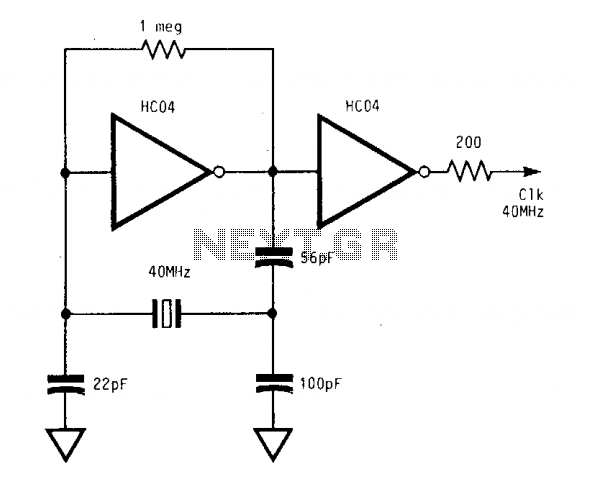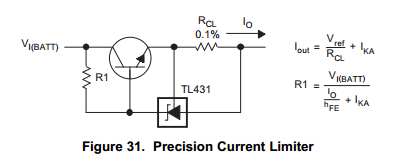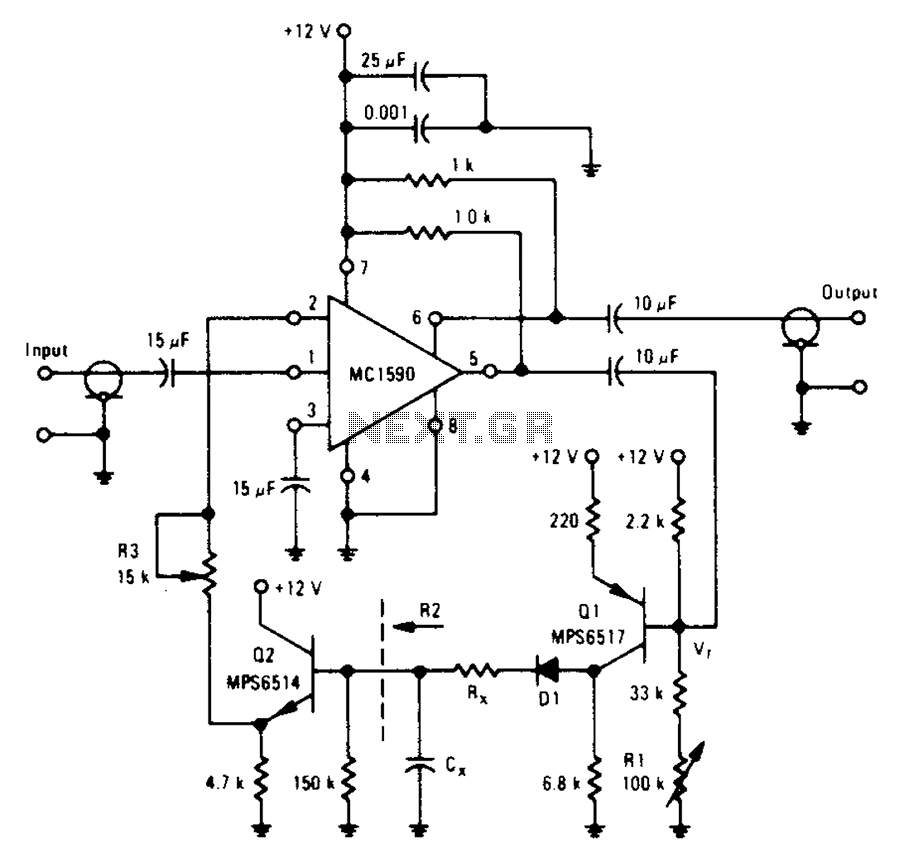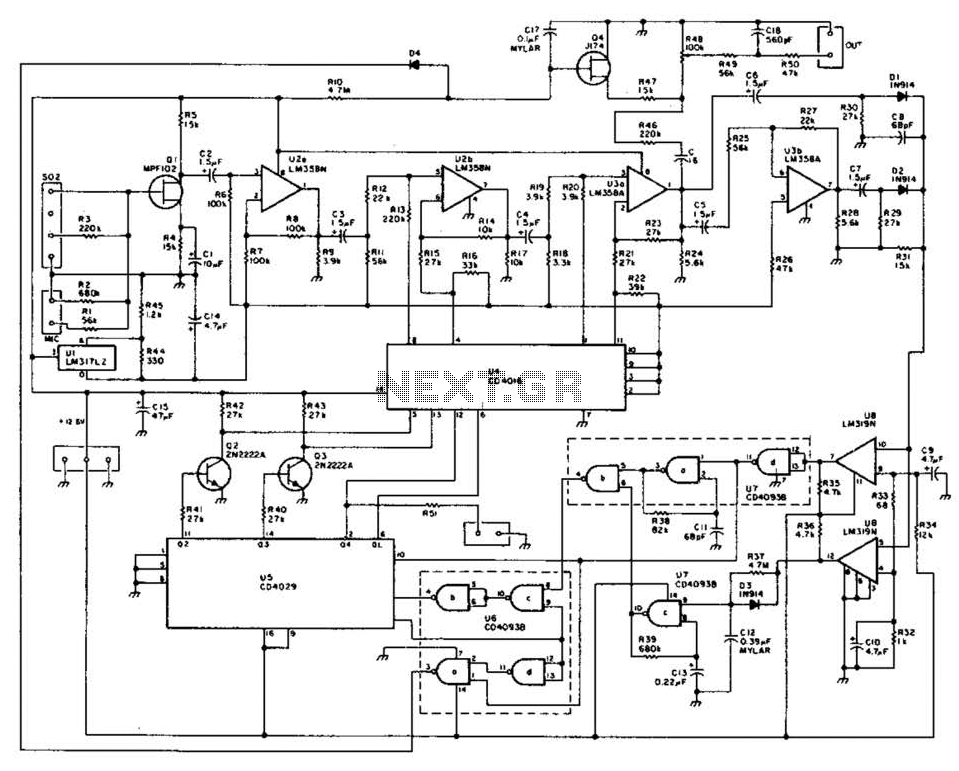
Z80 clock circuit

The circuit operates reliably from below 1 MHz to above 400 MHz. With a supply voltage (Vcc) of 5 V, the output of the second inverter achieves a full swing from 0 V to 5 V. These significant logic output levels and broad frequency range capabilities render this oscillator suitable for driving MOS components such as CPUs, controller chips, peripheral devices, and other TTL products. A damping resistor in series between the clock output of the oscillator and the input of the driven device will eliminate the undesirable undershoot and ringing caused by the high-speed CMOS component.
The described circuit functions as a high-frequency oscillator capable of generating signals across a wide frequency spectrum, from sub-MHz to over 400 MHz. The use of a 5 V supply voltage ensures that the output from the second inverter reaches the maximum logic levels, providing reliable high and low states essential for digital logic applications. This characteristic is particularly beneficial for interfacing with various digital components, including microprocessors, microcontrollers, and other peripheral devices that require precise timing signals.
To enhance the performance of the oscillator and mitigate potential signal integrity issues, a damping resistor is implemented in series between the oscillator's clock output and the input of the driven device. This resistor serves a critical function by attenuating any high-frequency noise, undershoot, or ringing that may occur due to the fast switching characteristics of CMOS technology. By smoothing out these transients, the damping resistor helps maintain signal fidelity and ensures that the receiving device interprets the clock signal accurately.
In designing this circuit, careful consideration should be given to the value of the damping resistor. An appropriate resistor value must balance between sufficient damping to eliminate ringing and undershoot while not excessively slowing down the signal rise and fall times. This balance is crucial for maintaining the overall performance of the circuit, particularly when interfacing with high-speed digital components.
Overall, this oscillator circuit represents a robust solution for generating high-frequency clock signals, with the added advantage of signal integrity enhancement through the use of a damping resistor. Its wide frequency range and compatibility with various digital devices make it a versatile choice for numerous electronic applications.The circuit will operate reliably from below 1 MHz to above 400 MHz. With Vcc = 5 V the output of the second inverter essentially attains a full swing from 0 V to 5 V. Such large logic output levels and broad frequency range capabilities make this oscillator quite suitable for driving MOS components such as CPU, controller chip, peripheral devices, as well as other TTL products. A damping resistor in series between the clock output of the oscillator and the input of the device being driven will remove the undesirable undershoot and ringing caused by the high speed CMOS part. 🔗 External reference
The described circuit functions as a high-frequency oscillator capable of generating signals across a wide frequency spectrum, from sub-MHz to over 400 MHz. The use of a 5 V supply voltage ensures that the output from the second inverter reaches the maximum logic levels, providing reliable high and low states essential for digital logic applications. This characteristic is particularly beneficial for interfacing with various digital components, including microprocessors, microcontrollers, and other peripheral devices that require precise timing signals.
To enhance the performance of the oscillator and mitigate potential signal integrity issues, a damping resistor is implemented in series between the oscillator's clock output and the input of the driven device. This resistor serves a critical function by attenuating any high-frequency noise, undershoot, or ringing that may occur due to the fast switching characteristics of CMOS technology. By smoothing out these transients, the damping resistor helps maintain signal fidelity and ensures that the receiving device interprets the clock signal accurately.
In designing this circuit, careful consideration should be given to the value of the damping resistor. An appropriate resistor value must balance between sufficient damping to eliminate ringing and undershoot while not excessively slowing down the signal rise and fall times. This balance is crucial for maintaining the overall performance of the circuit, particularly when interfacing with high-speed digital components.
Overall, this oscillator circuit represents a robust solution for generating high-frequency clock signals, with the added advantage of signal integrity enhancement through the use of a damping resistor. Its wide frequency range and compatibility with various digital devices make it a versatile choice for numerous electronic applications.The circuit will operate reliably from below 1 MHz to above 400 MHz. With Vcc = 5 V the output of the second inverter essentially attains a full swing from 0 V to 5 V. Such large logic output levels and broad frequency range capabilities make this oscillator quite suitable for driving MOS components such as CPU, controller chip, peripheral devices, as well as other TTL products. A damping resistor in series between the clock output of the oscillator and the input of the device being driven will remove the undesirable undershoot and ringing caused by the high speed CMOS part. 🔗 External reference
Warning: include(partials/cookie-banner.php): Failed to open stream: Permission denied in /var/www/html/nextgr/view-circuit.php on line 713
Warning: include(): Failed opening 'partials/cookie-banner.php' for inclusion (include_path='.:/usr/share/php') in /var/www/html/nextgr/view-circuit.php on line 713





